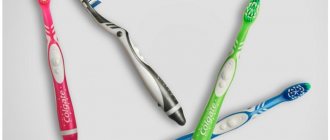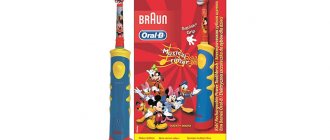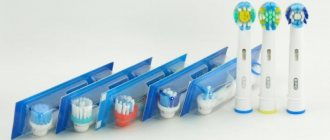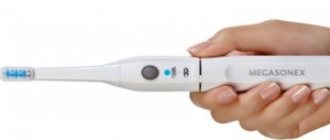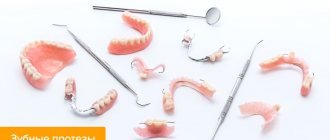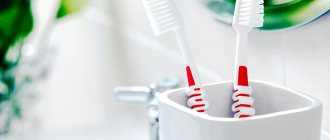The quality of oral care determines the health of teeth, their protection from the influence of cariogenic microbes, the absence of an unpleasant odor, as well as the whiteness and beauty of a smile. To keep your mouth clean, you need a reliable companion – a toothbrush. The characteristics it has determine how atraumatically and efficiently the enamel will be cleaned. What takes better care of your teeth: a soft toothbrush or a hard one? How to choose the right dental assistant? Let's take a closer look at these issues.
Toothbrush material
Almost all modern brushes are made from nylon fibers. Previously, hygiene products were produced with bundles of animal hair. And the first prototypes of modern dental devices, invented in Ancient Egypt, generally consisted of disintegrated plant branches.
Dentists say that it is necessary to buy only synthetic brushes, explaining that natural materials are highly hygroscopic, and this leads to the proliferation of pathogenic bacteria in the villi of the brushes. Another disadvantage of natural bristles is excessive fragility, which leaves sharp edges that can injure the enamel.
What determines the choice of hardness level?
There are five degrees of hardness:
- very soft;
- soft;
- average;
- hard;
- very tough.
The choice of hardness level is influenced by various indicators:
- Age. Children are advised to buy toothbrushes with soft bristles . This requirement is due to the immaturity of dental tissues for several years after teething.
- Periodontal condition. For healthy gums, it is optimal to brush your teeth with a product of medium hardness. But if the patient notices bleeding, loose gums, mobility of teeth or ulcerations on soft tissues, then it is better to choose a soft toothbrush.
- Availability of prostheses and orthodontic structures. When wearing artificial products in the mouth, dentists recommend using devices with hard bristles to improve hygiene.
- Hyperesthesia. If your teeth are sensitive, cleaning with an ordinary brush can be a real torture. Products with soft bristles are suitable for such people.
Recommendations when choosing
There is a wide variety of brushes, so to choose the right product for yourself, consult your dentist.
Simple rules will also help you make your choice:
- choose a brush with artificial bristles, it will last longer and will not contribute to the growth of bacteria on the bristles,
- the standard length of the head is 2.5-3 cm - this is the optimal size for an adult,
- pay attention to the end of the bristles - it should be smoothly rounded so as not to cause injury,
- If the dentist has not prescribed a specific type of brush, then buy a product of medium hardness, because too hard bristles can scratch the enamel, and soft bristles will not remove soft deposits well.
Who should use a soft toothbrush?
A soft-bristled toothbrush is recommended:
- children under 10-12 years of age;
- people who suffer from bleeding when brushing their teeth;
- patients with diabetes mellitus;
- in case of blood clotting disorders;
- with third degree tooth mobility;
- with pathological abrasion and wedge-shaped defects;
- for periodontal diseases.
In addition to the degree of hardness, it is necessary to pay attention to the technique of cleaning the tooth surface. Sometimes the wrong technique can harm hard tissues.
What to consider when buying a brush
The choice of brush hardness will be influenced not only by the condition of the oral cavity and teeth, but also by other factors.
- age: soft brushes are used by children and elderly people who have any problems with their teeth; the rest use a medium or hard brush.
- condition of the oral mucosa and gums: in case of pathology, you need to purchase soft bristles;
- presence of dentures or braces: the mouth needs to be cleaned more thoroughly. And only a hard brush can do this;
- condition of the enamel: if it is thinned, you should use a soft brush, in other cases - a hard one.
Which brush to use for brushing your teeth - hard, soft or medium (medium) - will depend solely on your sensations, the condition of your oral cavity and concomitant diseases. The “golden mean” has always been considered the optimal solution, but in any case you should definitely consult a dentist.
Are there any contraindications?
There is no list of contraindications for using a soft toothbrush, however, this does not mean that such a device cannot harm your teeth. The main disadvantage of soft bristles is that the degree of cleaning of the enamel is not good enough compared to normal or hard bristles.
Don't use a soft toothbrush:
- with a tendency to increased stone formation and accumulation of dental plaque;
- people who smoke;
- persons with a completely healthy oral cavity;
- with crowded teeth.
The use of soft bristles products for hygiene in such people is undesirable due to inadequate cleaning of the tooth surface and the likelihood of leaving plaque behind.
How to properly care for the product
In order for the product to serve you as long as possible, it should be stored properly and kept clean. Here are some basic recommendations in this regard:
- Obviously, each member of the family should have his own brush. Devices can be stored in a cup specially designated for this purpose, but care must be taken that the working areas do not come into contact with each other,
- they should be kept separate from razors and other hygiene items,
- The model for mechanical cleaning and the nozzle for electric/ultrasonic cleaning must be changed every 3 months. After treating caries or mucosal infections, you should buy a new product,
- After each procedure, it is recommended to thoroughly wash the bristles and treat them with soap - leave this until the next cleaning.
Everyone should have their own personal toothbrush.
A closed case is not the best solution for permanent storage. Only if it is not a special ventilated case for an electric or ultrasonic model. Once a week, the product can be placed in an antibacterial bath for disinfection.
Regular or electric soft toothbrush?
An electric toothbrush allows you to provide better oral care. This is due to the small size of the working part, due to which it is able to penetrate into hard-to-reach areas of the oral cavity. In addition, the electric device performs not only reciprocating movements, but also circular ones, and modern models are supplemented with a pulsating rotation mode.
Children love to brush their teeth with electric brushes. This makes them feel more grown-up and also makes oral care a fun game. Electric dental devices often come with soft attachments that are intended for children.
There are situations where using a battery-powered brush can be harmful:
- Severe tooth mobility.
- Recovery period after surgery on soft tissues of the oral cavity.
- Stomatitis.
- Hypertrophic gingivitis.
- Malignant neoplasms.
If you are prone to abrasion of enamel, you should alternate between a soft manual toothbrush and an electric one.
How often to change the brush
Doctors recommend changing the brush for an adult every 2-3 months, for a child - a month after the first use. Even if it is in excellent condition, it will still have to be thrown away. Brushes often fail prematurely because they are not always handled with care. They need to be replaced if they become shaggy, the bristles fall out and delaminate. Using them is useless and dangerous, as you can injure your gums and enamel.
Nozzles from electric brushes last a little longer - up to 4 months. Some have a wear indicator. If the blue hairs start to lighten, it's time to replace the device head.
Review of the most popular models
The assortment of every manufacturer producing oral hygiene products includes models with soft tufts.
Let's consider the most popular:
- SPLAT Professional Sensitive - the villi are split into four parts, each of which is rounded to avoid injury. The bristles are impregnated with silver ions, which protect against bacterial attack on the teeth.
- LACALUT Sensitive - equipped with soft bristles that protect tooth enamel from damage and gently cleanse the oral cavity.
- Colgate 360 Sensitive Pro-Reliev - in addition to the fine bristles, there is a tongue brush on the back of the head. Among the tufts there are rubber cups that allow you to polish the tooth surface.
- Jordan Target Sensitive - has a small working part, which makes it possible to penetrate well into the back of the mouth. Ultrasoft bristles have a diameter of 0.01 mm.
How to choose a brush based on the shape of the bristles
The bristles of a toothbrush can be single-level, two-level, three-level and multi-level. Research shows that multiple levels of bristles provide better cleaning between teeth and gum pockets.
Based on the arrangement of the beams, three types of brushes are distinguished:
- Hygienic: with even and straight bundles of the same length. This is a very ordinary brush with minimal functionality. Usually such models are bought for children.
- Preventive: the beams are located in different directions, have different lengths and even rigidity. There may be rubber bristles on the sides of the brush that massage the gums while brushing your teeth.
- Special: designed for cleaning braces, implants and other structures. Such brushes are sold in pharmacies and can be made to order. It is better to buy them after consulting a dentist.
These are the main parameters of toothbrushes. Today, many models are available with additional functions. If you wish, you can choose a good brush that will massage your gums, clean your tongue, etc.
Is it possible to make a toothbrush soft?
If your new brush is too hard for you, there are ways to soften your toothbrush:
- Place the head under running hot water.
- Gently knead the stubble with your fingers.
- Place the brush in a container of warm vinegar for half an hour.
Still, the most correct thing in this situation would be to purchase a new brush with different, softer bristles.
The choice of a toothbrush must be approached consciously, because the level of oral care, prevention of caries and gum disease depends on its quality. In order not to damage the enamel, it is necessary not only to use the right brush, but also to follow the technique of cleaning your teeth. And do not forget that each brush must be replaced after 3 months of use.
Author: Violeta Kudryavtseva, doctor, especially for Mama66.ru
Features of the location of the bristles
More than half a century ago, people used toothbrushes made from both natural bristles and synthetic fibers. Now scientists have proven that it is permissible to use only products with artificial bristles, because a natural brush absorbs moisture, and this provokes the growth of microorganisms.
The end part of the villi is always rounded so as not to scratch the surface of the enamel and soft tissues of the oral cavity. Nylon bristles are grouped in tufts, which are arranged in various ways along the surface of the plastic head. According to the height of the pile, brushes come with a single-level arrangement of elements, two-, three-, and also multi-level.
The beams are fixed to the site in a special way, and can be installed both parallel to each other and at different angles. The difference in location allows for more complete cleansing of all tooth surfaces.
